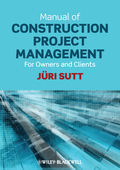
This construction client's manual is written in the form of a list of activities. It supports owners in the role of client by helping them make choices during the project development process. This increases control over cost, qualityand duration at each stage. Activities within each main stage of the project development (preparation stage; procurement; design; preparation for construction; construction itself; handover; implementation) are divided into phases, each requiring separate decision-making. The phase begins with a list of directprevious decisions and continues with a list of executors, the goal of the present phase and a list of activities to be performed. And each phase ends witha list of expected results and a list of activities that these results release for action in the next phase. The sequence of these seven stages can be altered to help building owners manage risk by choosing and combining the timing of these stages. The tasks involved in project preparation, described in the first chapter are for example, often left by the owner for the designers to solve - or sometimes even the contractors. The decisions relating to the choice ofprocurement schemes, described in the second chapter, can be made either at the preparation stage of project development, as part of the prioritisation of aims, or at the time of choosing the designer, or at the stage of choosing construction contractors. Manual of Construction Project Management for owners & clients is for prospective owners who either operate as clients themselves, orwho use the services of professional construction management companies. The aim is to help both owners and their construction partners understand what to expect from each other. The manual describes activities at the level of detail required to choose the management task or method to make the decision. It is not bound to regulations of any specific country and a detailed glossary makes it an indispensable worldwide reference. INDICE: Preface. About the Author. Introduction. Glossary. Chapter 1: Preparation stage. 1.1 Project statement. 1.2 Appointment of a project manager andintegration of project management in the process management of the owner's company. 1.3 Needs and profi tability analysis. 1.4 Preparation of the fi nancial scheme and loan contracts. 1.5 Preparation for land purchase and corresponding contracts. 1.6 Feasibility studies and corresponding investigations. 1.7 Detailed area planning. 1.8 Scheme design. Chapter 2: Procurement stage. 2.1 Choice of procurement path. 2.2 Methods for choosing the contractor. 2.3 Process of tendering. Chapter 3: Design stage. 3.1 Preparation phase. 3.2 The choice of designer. 3.3 Contracting between client and designer (consultant). 3.4 Management of design. Chapter 4: Construction preparation stage. 4.1 Building permit application. 4.2 Construction procurement programme preparation (preliminary conditions of contract). 4.3 Choice of contractor. 4.4 Construction contracting. Chapter 5: Construction stage. 5.1 Construction management. 5.2 Owner's supervision and quality management. 5.3 Cost control. 5.4 Management of changesand additional works. 5.5 Management of the client's direct contracts. Chapter 6: Take-over stage. 6.1 Revisions of general construction work. 6.2 Revisions of engineering systems. 6.3 Building take-over. 6.4 The building's taking for use. 6.5 Project completion. 6.6 Warranty period. Appendices. Appendix. Listof the construction client's principal decisions. Appendix. List of document folders that should be completed during project development. Bibliography. Index.
- ISBN: 978-0-470-65824-6
- Editorial: John Wiley & Sons
- Encuadernacion: Rústica
- Páginas: 168
- Fecha Publicación: 03/06/2011
- Nº Volúmenes: 1
- Idioma: Inglés
